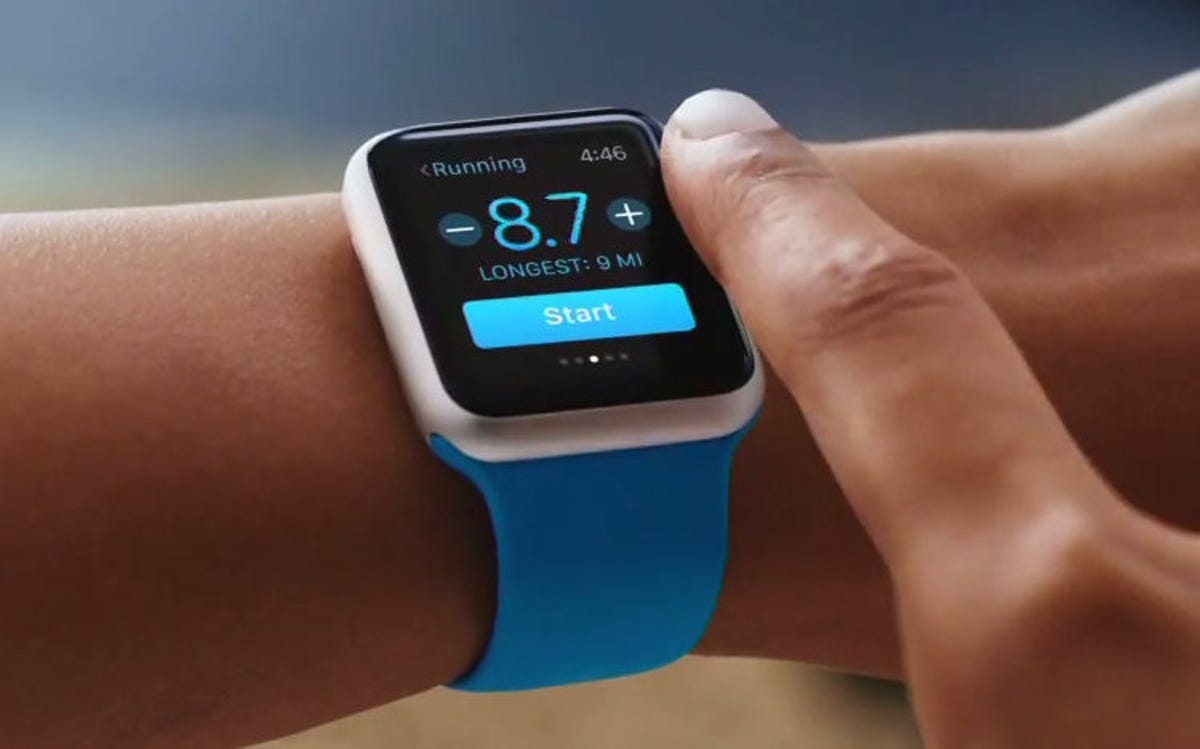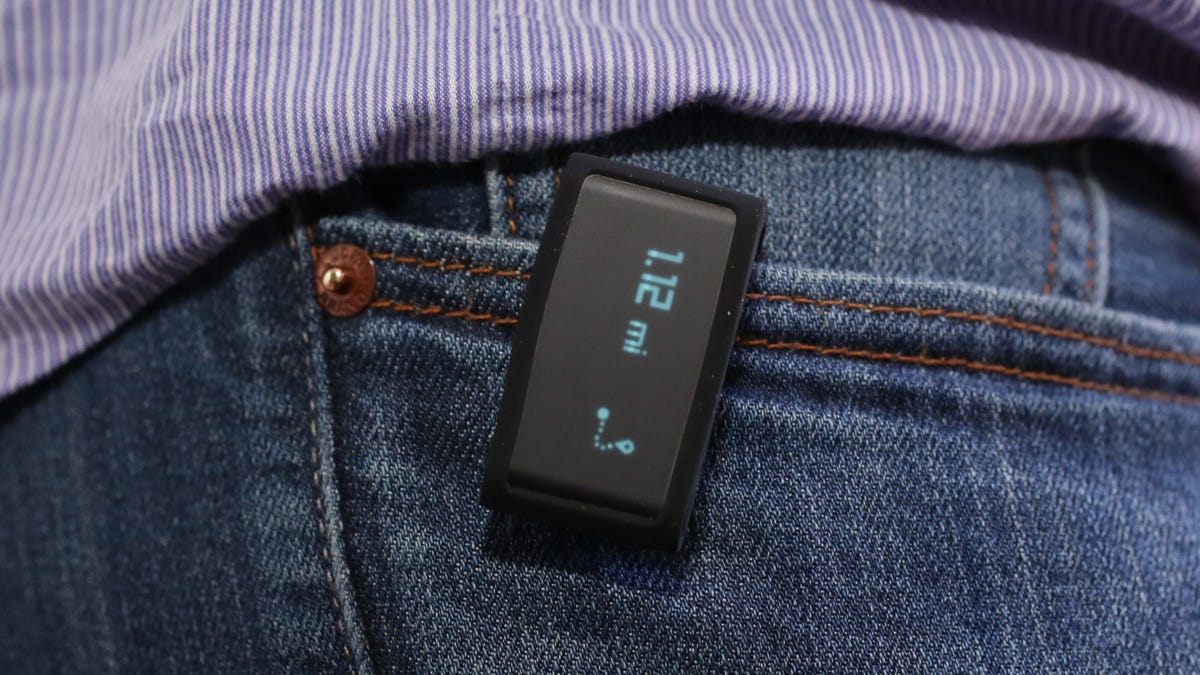
Video screenshot by Amanda Kooser/CNET
When Apple releases the Apple Watch next spring, people around the world will want to know what this long-awaited wearable can do, how it feels and what it means. But as all-consuming as that will be, the discussion misses the bigger issue: the value of the data the Apple Watch and its competitors churn out.
As gadgets measure our lives in new ways — often with the same sensors that now measure skin temperature, heart beat and respiratory rate — makers of smart wearables are thinking about ways to turn that biometric information into money-making services.
But there’s a hitch: a third of wearable device owners abandon their gadget after a year, according to a survey by PricewaterhouseCoopers. Devices that begin to do more than churn out charts will offer no real value if consumers don’t keep wearing them. There’s also the question of privacy. The Health Insurance Portability and Accountability Act (HIPAA), which protects patient data and medical records, doesn’t yet apply to user-generated wearable data. And the market for collecting and selling that information is a booming business for data brokers and hackers alike.
To clear those roadblocks, Apple’s wearable strategy extends well beyond the Apple Watch. Its plan hinges on HealthKit. Released as part of Apple’s iOS 8 mobile operating system update in September, HealthKit is expected to act as a nerve center of sorts, letting device and app makers share data they collect about you in potentially interesting new ways. Heart rate data gleaned from your smartwatch could be paired with respiratory data harvested from that smart shirt you’re wearing to alert your doctor you’re about to have heart attack or a stroke.
The possibilities are almost endless. That’s because HealthKit could one day deliver a meaningful snapshot of your health and fitness to physicians, emergency response teams, hospitals, and personal trainers — creating an App Store-like offering focused on health, which data Apple has promised cannot be sold to the highest bidder. Apple has already begun the process, partnering with the Mayo Clinic and leading electronic health record company, Epic Systems, to get all your health and fitness data in the hands of doctors.
Apple isn’t unique. Google earlier this month released Google Fit, its own health hub for Android users’ wearable data. Samsung, which offers numerous wearables under its Galaxy line of devices, is also working on a cloud-based software platform called SAMI that will analyze sensor readings from wearables for deeper analysis.
At your service
In every case, the goal is putting that data in the hands of those who can do something meaningful with it. The services that arise from those data troves — such as on-demand medical consultations, fitness coaching and weight-loss training — will help shape the wearable market, which by 2018 could reach 130 million units sold with a market value of $6 billion, according to market researcher IDC.
“The service is fundamental,” said Alexis Normand, head of health care development for French wearable maker Withings. “Wellness providers came to us and asked us to integrate our devices, to create incentives, and offer better rewards.”
Withings, which makes activity trackers alongside smart scales and sleep-tracking mattress pads, is among the few to have longstanding relationships with corporations and wellness programs. Employees at Massachusetts Institute of Technology, United Healthcare, and Palo Alto Medical Foundation, among others, use Withings devices and software to keep track of their health.


Sarah Tew/CNET
Corporate wellness programs ShapeUp and The Vitality Group base some of their services on Withings-generated data. Now, with the expected explosion of wearables, physicians and others are looking for new ways to ways to capitalize on health data.
“I think of it as a huge leap toward universal health care,” said Julia Hu, CEO of health and fitness coaching app Lark. Initially a wearables maker, Lark realized its phone-based coaching service delivered the greatest value to itself and others. Lark ditched the hardware, and now integrates with Apple’s HealthKit to gain more insights than it could with a single-serving fitness tracker.
“You go to a doctor, fitness trainer, or therapist once a week or even once a year,” Hu said. “You get them for a tiny fraction of your life and you get advice you have to apply 24 hours a day.” Health data could change that into “pervasive, preventable care,” that we see every day.
Even large companies like Nike have left wearable hardware behind to focus on software and services. Earlier this year, Nike discontinued development on its FuelBand device, choosing instead to put more resources into its Nike+ fitness training platform. With Apple Watch and HealthKit, Nike sees further growth in both selling more people on shoes and apparel, as well as tapping into more data to improve its service.
“Technologically we [Apple and Nike] can do things together that we couldn’t do independently,” Nike CEO Mark Parker told Bloomberg last month. “That’s part of our plan, to expand the whole digital frontier in terms of wearables, and go from what we say is tens of millions of users — right now there’s 25 million Nike+ users — to hundreds of millions.”
Despite these promises, medical professionals are quick to point out the industry is still trying to figure out the best way to wring value from health data.
“There’s this perception that more data is better. That’s not clear,” said Bryant Lin, a physician and assistant professor at Stanford School of Medicine. Lin consults for wearable maker iHealth, which specializes in connected devices for patients who suffer from diabetes and other serious conditions. “We’re going to want to see the evidence so that we don’t end up saying, ‘We have all this data, but it doesn’t make a difference.'”
Even so, wearables data is starting to deliver deeper insights into chronic conditions like high blood pressure, Lin said. Patients often show him their phone or bring in printed readouts of their data. “I can look at the trends and see if they’re under control, if they need their medication changed,” he said.
The next step, Lin thinks, is getting these kind of data streams standardized as part of electronic medical records — something Apple is actively working toward with Epic Systems. That would help doctors treat individual patients and enable medical researchers to identify larger trends, Lin said.
People skeptical about when, where and why our personal data will be collected and stored have reason to be confused. We could see de-identified data used in medical research, identifiable data shared with healthcare providers, along with personal privacy controls already found in programs like HealthKit that allow individuals to govern how different apps access and use their data. It’s important to know that, until the laws catch up, wearing a wearable means opening up your biometric data to a potential privacy breach.
“I think we will see a move toward more transparency, especially as consumers become aware of how valuable their data is,” said Luis Rincon, co-founder and CEO of market researcher Wearables.com. Until then, the advice to those adverse to having health information produced by these gadgets out in the wild is simple: don’t wear them.
Wearables without a data plan?
So what does a market shift to health services mean for the leading wearables makers?
How can Fitbit and Jawbone, which sell more health trackers than any other competitors, stay relevant as health services overshadow data snapshots?


Sarah Tew/CNET
Fitbit isn’t saying. The only clue is its refusal to integrate with HealthKit, suggesting either a data hub of its own, or a go-it-alone approach that relies entirely on its own devices and software. The company already offers Fitbit Premium, a $50 service that acts as a personal trainer. The service only relies on Fitibit data, but the company’s product line will soon include more devices like its Surge smartwatch with better sensors. The company did not respond to requests for comment.
Jawbone, which does partner with Apple on HealthKit, now positions itself more as a service provider than a strict gadget maker. In September, Jawbone opened its software platform to any smartphone and wearable that connect with Apple’s Health app, any Android Wear-compatible device and all Pebble smartwatches.
“Our vision is not about winning a hardware arms race, or just moving more units than the other guys,” Travis Bogard, Jawbone’s VP of product management, wrote in September. “By opening our system we can continue to embrace the innovation of others and we can build an even stronger community…”
Jawbone’s timing is appropriate.
“The worst place to be is just a gadget company that doesn’t offer a service or a data repository,” said Tim Chang, a venture capitalist at Mayfield Fund who co-founded wearable maker Basis Science, which Intel bought earlier this year for about $100 million.
Without a service, said Chang, “you might as well get out of the game.”



